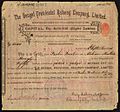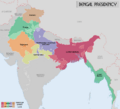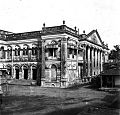Bengal Presidency facts for kids
The Bengal Presidency was a large and important area of British India during the time of British rule. It was mainly made up of the region known as Bengal. Today, this historical area is split into Bangladesh and several states in India.
These Indian states include:
Over time, the Bengal Presidency also grew to include other areas. These parts are now in Pakistan and other Indian states. Some of the Indian areas that were once part of the presidency are Uttar Pradesh, Uttarakhand, Punjab, Haryana, and Himachal Pradesh. It also included parts of Chhatisgarh, Madhya Pradesh, and Maharashtra. In Pakistan, it covered the North-West Frontier and British Punjab provinces. Even Burma was once part of it. Penang and Singapore were also considered part of the Presidency until 1867. They then became part of the Crown Colony of the Straits Settlements.
Contents
How the British Arrived in Bengal
The British first came to Bengal for trade. They were part of the East India Company. This company was given permission to trade by the Mughal Emperor Jahangir. At first, they just wanted to buy and sell goods.
Early Trade and Power
The East India Company slowly gained more power. They built trading posts and forts. Over time, they started to get involved in local politics. This led to conflicts with the local rulers.
The Battle of Plassey
A major turning point was the Battle of Plassey in 1757. The British, led by Robert Clive, defeated Siraj-ud-Daulah. He was the last independent ruler of Bengal. This victory gave the British a lot of control over Bengal. It marked the start of their official rule in India.
Governing the Presidency
After gaining control, the British set up a system to rule Bengal. They appointed governors and officials. The main city and capital of the Bengal Presidency was Calcutta. It became a very important center for trade and administration.
Important Governors
Many important figures governed the Bengal Presidency. One of them was Warren Hastings. He was the first Governor-General of Bengal. He faced challenges but helped set up the British administration. Later, Lord William Bentinck became Governor-General. He made big changes, like making English the main language for schools.
Developing Infrastructure
The British also worked on building new things. They developed railways, telegraph lines, and postal services. Lord Dalhousie is often given credit for these improvements. These changes helped the British control the vast area more easily. They also helped with trade and communication.
Life in the Bengal Presidency
Life in the Bengal Presidency was a mix of old and new. Many people lived in villages and worked in farming. But cities like Calcutta grew very fast. They became centers for business, education, and culture.
Culture and Education
The British brought their own culture and education system. However, local reformers also played a big role. People like Raja Ram Mohun Roy worked to improve education and society. They helped blend traditional Indian learning with new ideas.
Economic Activities
Bengal was rich in resources. Jute was a very important crop. Mills were built to process jute, creating many jobs. Ports like Calcutta and Port of Narayanganj were busy with ships trading goods.
Changes and Challenges
The Bengal Presidency faced many changes and challenges over the years. These included political decisions and difficult times.
The Partition of Bengal
In 1905, Lord Curzon, who was the Viceroy of India, decided to divide Bengal. This was called the first partition of Bengal. He created a new province called Eastern Bengal and Assam. This decision caused a lot of protests and unhappiness among the people.
Annulment and Capital Shift
Because of the strong protests, the partition was later cancelled. In 1911, King George V announced that the partition would be undone. He also announced that the capital of British India would move from Calcutta to New Delhi. This was a big moment in the history of British India.
Difficult Times
The region also faced tough times. For example, the Bengal famine of 1943 was a terrible event. Many people suffered and lost their lives during this period.
The End of the Presidency
The Bengal Presidency continued until India gained independence. In 1947, British rule ended. The old Bengal Presidency was then divided. This led to the creation of Bangladesh (then East Pakistan) and the Indian state of West Bengal. This marked the end of a long and important chapter in history.
Images for kids
-
Robert Clive at the Battle of Plassey in 1757, which marked the defeat of the last independent Nawab of Bengal Siraj-ud-Daulah
-
A statue in Calcutta Victoria Memorial of Lord Curzon, who announced the creation of Eastern Bengal and Assam on 16 October 1905
-
In 1911, King George V announced the annulment of the first partition of Bengal and the transfer of British Raj India's capital from Calcutta to New Delhi
-
Raja Ram Mohun Roy, a native reformer and educationist
-
Lord Dalhousie is credited for developing railways, telegraph and postal services
-
Royal Air Force planes in Chittagong Airfield
-
Rabindranath Tagore (while in London in 1879) and Kazi Nazrul Islam (while in the British Indian Army in 1917–1920)
-
Painting by Johann Zoffany of Governor-General Warren Hastings and his wife Marian at their garden in Alipore
See also
 In Spanish: Presidencia de Bengala para niños
In Spanish: Presidencia de Bengala para niños





































